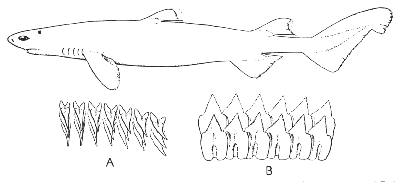Dalatias licha (Bonnaterre) 1788
[Bigelow and Schroeder, 1948, p. 502.]
Description—
This shark resembles the Portuguese shark in the relative sizes and positions of its fins; also in its scales. But its dorsal fins do not have any trace of spines, while the serrate margins of its lower teeth, in combination with their triangular shape, mark it off from any other shark without an anal fin that is known yet from the North Atlantic. Its trunk is rather slender, its snout short and bluntly rounded, and the lower-anterior corner of its tail fin is not expanded as a definite lobe. Its upper teeth are slender, awl- [page 56] shaped, curving somewhat outward toward the corners of its mouth; but the lowers are erect, broadly triangular, with serrate edges.
Color—
Dark chocolate, cinnamon, or violet brown below as well as above; the upper surface sometimes with poorly defined blackish spots; the dorsal and pectoral fins with pale or whitish edges, the tail tipped with black.
Size—
Most of those caught are between 40 and 60 inches long; 72 inches is the longest recorded so far. The Gulf of Maine specimen illustrated in figure 22 was about 5 feet long and weighed 23½ pounds, gutted.
General range—
Eastern Atlantic, from tropical West Africa to the Irish Atlantic slope; recorded once from the American coast.
Occurrence in the Gulf of Maine—
Our only reason for mentioning this shark is that a female, about 5 feet long, was taken on the northern edge of Georges Bank on August 19, 1937 (fig. 22).[53]
